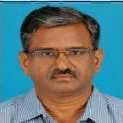
E.Venkateswarlu
Work place: Data Processing, Products Archival and Web Applications Area, National Remote Sensing Center (NRSC), ISRO, Hyderabad, India.
E-mail: venkateswarlu_e@nrsc.gov.in
Website:
Research Interests: Computer Science & Information Technology, Image Compression, Image Manipulation, Image Processing, Data Structures
Biography
E.Venkateswarlu, M.Sc., M.Phil. in Mathematics, is currently working as Scientist “SF” in DPPA&WA area of NRSC, ISRO. He has published 6 research papers in reputed conferences and journals. His research interests include Image Processing, Data Quality Assurance, etc
Author Articles
Generation of Analysis Ready Data for Indian Resourcesat Sensors and its Implementation in Cloud Platform
By Thara Nair Akshay Singh E.Venkateswarlu G.P.Swamy Vinod M Bothale B. Gopala Krishna
DOI: https://doi.org/10.5815/ijigsp.2019.06.02, Pub. Date: 8 Jun. 2019
The introduction of remote sensing techniques had lead us into a new race of advanced data processing applications. The analysis ready data is also a part of it which is generated at the producer end to facilitate its user to directly go on to the application part. This paper highlights the generation, processing and cloud applications of the Analysis Ready Data (ARD) using ISRO's Satellites Resourcesat-2 and Resourcesat-2A's LISS-3 sensor data. The proposed work includes use of terrain corrected data for generating Radiance, Top of Atmosphere (ToA) Reflectance, Normalized Difference Vegetation Index (NDVI), Enhanced Vegetation Index (EVI) and Time series analysis with pixel level Quality Assessment (QA) for all the generated data products. A graphical user interface has been developed for online ordering of data by the user. This paper also highlights the implementation of the developed application in cloud platform using the cloud computing model, Platform as a Service (PaaS).This facilitates the users to generate the ARD products from any device, facilitating a quick and all time available transmission rate for the customers.
[...] Read more.Scene based Non-uniformity Correction for Optical Remote Sensing Imagery
By Lolith Gopan E.Venkateswarlu Thara Nair G.P.Swamy B. Gopala Krishna
DOI: https://doi.org/10.5815/ijigsp.2017.12.06, Pub. Date: 8 Dec. 2017
In this work, we propose and evaluate different scene based methods for non-uniformity corrections for optical remote sensing data sets. These methods can be used to correct or refine the existing radiometric calibrations, thereby improving the image quality. The performance of each algorithm against different datasets are analyzed and a quantitative comparison of different quality parameters viz. entropy, correlation coefficient, signal to noise ratio, peak signal to noise ratio and structural similarity index are carried out to recommend the best method for each scene. For a given data set, the selected method depends on the severity, type of terrain it covered, etc.
[...] Read more.Estimation of NIIRS Incorporating an Automated Relative Edge Response Method
By Pranav V E.Venkateswarlu Thara Nair G.P.Swamy B. Gopala Krishna
DOI: https://doi.org/10.5815/ijigsp.2017.11.04, Pub. Date: 8 Nov. 2017
The quality of remote sensing satellite images are expressed in terms of ground sample distance, modular transfer function, signal to noise ratio and National Imagery Interpretability Rating Scale (NIIRS) by user community. The proposed system estimates NIIRS of an image, by incorporating a new automated method to calculate the Relative Edge Response (RER). The prominent edges which contribute the most for the estimation of RER are uniquely extracted with a combined application of certain filters and morphological operators. RER is calculated from both horizontal and vertical edges separately and the geometric mean is considered as the final result. Later applying the estimated RER along with other parameters, the system returns the NIIRS value of the input image. This work has proved the possible implementation of automated techniques to estimate the NIIRS from images and specifics in the metafile contents of imagery.
[...] Read more.Other Articles
Subscribe to receive issue release notifications and newsletters from MECS Press journals